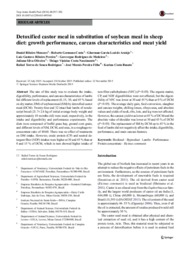Detoxified castor meal in substitution of soybean meal in sheep diet: growth performance, carcass characteristics and meat yield.
Detoxified castor meal in substitution of soybean meal in sheep diet: growth performance, carcass characteristics and meat yield.
Author(s): MENEZES, D. R.; COSTA, R. G.; ARAUJO, G. G. L. de; PEREIRA, L. G. R.; MEDEIROS, G. R. de; OLIVEIRA, J. S.; NASCIMENTO, T. V. C.; RODRIGUES, R. T. de S.; PEREIRA FILHO, J. M.; BUSATO, K. C.
Summary: The aim of this study was to evaluate the intake, digestibility, performance, and carcass characteristics of lambs fed different levels of replacement (0, 15, 30, and 45 % based on dry matter, DM) of soybean meal (SM) by detoxified castor meal (DCM). Twenty-four and 32 intact hair lambs of nondescript breed (21.7 ± 2.6 kg of initial average body weight and approximately 10 months old) were used, respectively, in the intake and digestibility and performance experiments. The diets were composed of buffel grass hay, ground corn grain, and different levels of SM, DCM, and urea, in a roughage-to-concentrate ratio of 40:60. There was no effect of treatments on DM intake. However, crude protein (CP) and neutral detergent fiber (NDF) intakes were higher at 30 and 45 % than at 0 and 15 % of DCM, which in turn showed higher intake of non-fiber carbohydrates (NFC) (P < 0.05). The organic matter, CP, and NDF digestibilities were not affected, but the digestibility of NFC was lower at 30 and 45 % than at 0 % of DCM (P < 0.05). The average daily gain, feed conversion, slaughter and carcass weights, chilling losses, ribeye area, and absolute values and yields of neck, ribs, loin, and leg were not affected. However, the carcass yield was lower at 45 % of DCM and the absolute value of shoulder was lower at 30 and 45 % of DCM (P < 0.05). The replacement of SM by DCM up to 45 % in the feed of lambs did not negatively affect the intake, digestibility, performance, and main carcass features.
Publication year: 2016
Types of publication: Journal article
Unit: Embrapa Semi-arid Region
Observation
Some of Embrapa's publications are published as ePub files. To read them, use or download one of the following free software options to your computer or mobile device. Android: Google Play Books; IOS: iBooks; Windows and Linux: Calibre.
Access other publications
Access the Agricultural Research Database (BDPA) to consult Embrapa's full library collection and records.
Visit Embrapa Bookstore to purchase books and other publications sold by Embrapa.

